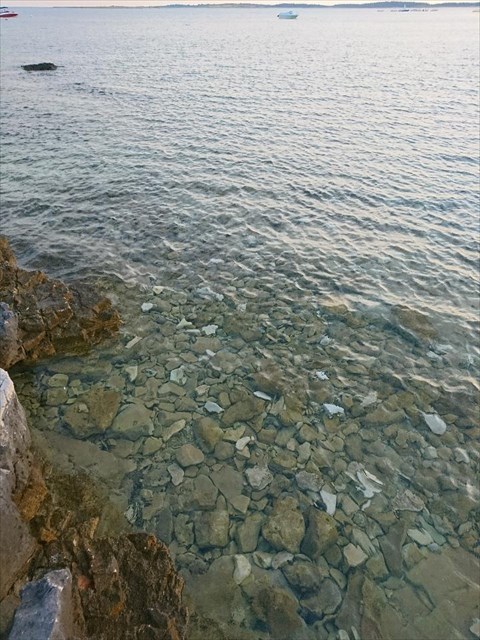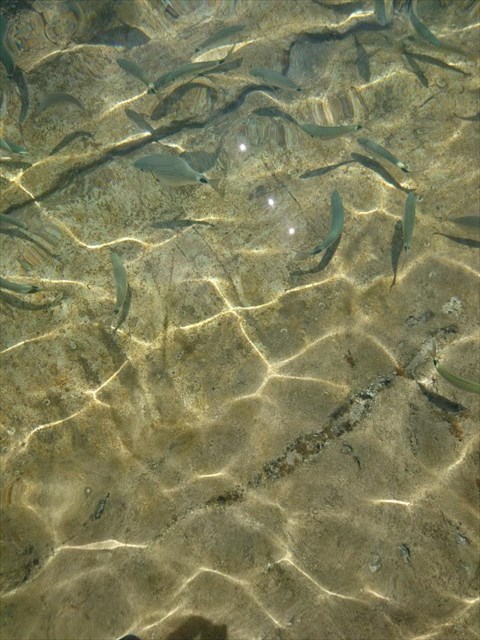ENGLISH
Erosion of fossils
Erosion is often considered negatively, however makes it possible to discover fascinating objects in different occasions. In paleontolgy, erosion makes finds like fossils or bones possible. Discover the erosion of fossils with this earthcache! Combine geologic interest with diving!
Erosion
Erosion is the process that removes soil, rock oder dissolved material on the Earth's crust. It contains the erosion of weathered stones or loose sediments including earth soil. Most erosion is linear. Due to water flows in small channels or in flowing waters, depressions in stones evolve. Other forms of erosion are wind, surf, ice or precipitation.
Abrasion
Abrasion attacks the mainland on a broad scale and is very well visible on cliff lines and stones on the beach. The surf of the sea is working permanently on the stones, hollow them out and erodes layer after layer. A continuously growing area evolves.
Fossils
Fossils are corporal remains of cinmals and creatures and their traces. The formation of fossils is the taphonomy or fossilisation . The research of fossils is done by paleolontologists.
Complete bodies or parts of bodies of dead creatures are called corporal fossils. Fossils are formed by different factors after the death of the animal. e.g. Chemistry, biochemistry, geology and physiology. After the death and decomposition different reasons can lead to fossilisation, e.g. mumification, sand, wet sand, mud, ice, salt,... The body is covered by sediments and fossilised by heat and pressure. Fossils remain in the ground for millions of years until they are revealed by erosion. Hard parts like bones, teeth or shells are petrified.
Sources:
https://en.wikipedia.org/wiki/Taphonomy
https://en.wikipedia.org/wiki/Fossil
https://en.wikipedia.org/wiki/Erosion
Erosion of fossils
In this earthcache you can find fossils which can be seen in a lot of parts in Istria .The speciality is that you can find the difference of hardly and strongly eroded fossils very close together. Discover this particularity in geology!
Preparation:
To get to the earthcache location you have three possibilities:
-
By boat and swimming (please watch out for swimming persons!)
-
Via the official entry of the FKK/nudism camp site Kazela (you have to pay 25 HRK per person): official access
-
Via another access on the beach: alternative access
The earthcache location is in the water.
This earthcache consists of two parts:
-
Get to the listing coordaintes. You find a big rock in the water which contains fossils. Describe the fossils (size, color, which kind of animals)

-
Move to the coordinates of waypoint 1. Here you need diving or snorkeling equipment. Have a look at the great rock under water. You also see fossiles. Describe them (size, color, which kind of animals).

Use your discoveries to answer the following questions regarding the erosion of fossils:
-
Which of the fossils are more eroded?
-
How do you see this?
-
Why are they more eroded?
-
How is this form of erosion called?
It is not necessary to wait for my answer. After you sent the answers, you can log directly. Logs without previous answers by email or message center will be deleted without notice.
Please note that snorkeling or diving is on your own risk. The water is about 1-2 m deep. If adults supervise the geodiving, children who are interested in fossiles can also do this earthcache. Parents might help to answer the questions.
Enjoy geosnorkeling and the discovery of Istrian fossils!
DEUTSCH
Erosion von Fossilien
Erosion wird häufig als negativ betrachtet, ermöglicht aber bei manchen Gelegenheiten faszinierende Entdeckungen. In der Paläontologie werden viele Funde von Fossilien und Knochen erst durch Erosion möglich. Erkundet die Erosion von Fossilien mit diesem Earthcache! Kombiniert geologisches Interesse mit einem Tauchgang!
Erosion
Erosion ist ein im Gesteinskreislauf. Er beinhaltet die Abtragung von verwitterten Gesteinen oder lockeren Sedimenten einschließlich der Böden. Am häufigsten auf der Erde findet man die lineare Erosion. Durch abfließendes Wasser in kleinen Rillen oder in Fließgewässer entstehen Eintiefungen in Gesteinen. Andere Formen der Erosion entstehen durch Wind, Meeresbrandung, Inlandeis oder auch durch Niederschläge.
Abrasion
Abrasion greift das Festland auf breiter Front an und lässt sich besonders gut an Steilküsten oder Gesteinen am Strand beobachten. Die Brandung bearbeitet die Gesteine permanent, höhlt sie aus oder trägt Schicht für Schicht. Es entsteht eine immer breiter werdende Fläche.
Fossilien
Fossilien sind körperliche Überreste von Lebewesen oder deren Spuren. Die Entstehung von Fossilien nennt man Fossilisation. Die Erforschung der Fossilien erfolgt meistens durch die Paläontologie.
Als Körperfossilien werden ganze Körper oder Körperteile von toten Lebewesen bezeichnet. Fossilien entstehen durch verschiedene Faktoren nach dem Tod des Lebewesens, z.B. Chemie, Biochemie, Geologie und Physiologie. Nach Tod und Verwesung können verschiedene Gründe zur Fossilisation führen, z.B. Mumifikation, Wüstensand, Schwemmsand, Schlamm, Eis, Salz,... Der Körper wird bedeckt und durch Hitze und Druck versteinert. Fossilien bleiben in der Regel Millionen von Jahren im Boden, bis Sie durch Erosion freigelegt werden. Harte Bestandteile wie Knochen, Zähne oder Schalen werden versteinert.
Fossilien bleiben in der Regel Millionen von Jahren im Boden, bis Sie durch Erosion freigelegt werden. Harte Bestandteile wie Knochen, Zähne oder Schalen werden versteinert.
Quellen:
https://de.wikipedia.org/wiki/Fossilisation
https://de.wikipedia.org/wiki/Fossil
https://de.wikipedia.org/wiki/Erosion
Erosion von Fossilien
In diesem Earthcache könnt ihr Fossilien finden, die es in Istrien häufig zu sehen gibt. Das besondere ist aber, dass ihr in unmittelbarer Nähe die Unterschiede zwischen stark und schwach erodierten Fossilien erkennen könnt. Die Spezialität dieses Ortes wird durch diesen Earthcache beschrieben.
Vorbereitung:
Um zum Earthcache zu gelangen, gibt es drei Möglichkeiten:
-
Mit dem Boot und dann ein Stück schwimmen (bitte auf badende Gäste achten!)
-
Über den offiziellen Eingang des FKK-Campingplatzes Kazela (hier werden 25 Kuna Eintritt pro Person fällig): official access
-
Über einen weiteren Zugang am Strand: alternative access
Der Earthcache befindet sich im Wasser.
Dieser Earthcache besteht aus zwei Teilen:
-
Begebe dich zu den Listing-Koordinaten. Hier findest du einen großen Fels im Wasser, der Fossilien trägt. Beschreibe die Fossilien (Größe, Farbe, welche Art von Tieren)

-
Begebe dich zu den Koordinaten des Wegpunkts 1. Hier benötigst du Schnorchel- oder Tauchausrüstung. Tauche unter Wasser und wirf einen Blick auf den großen Felsen. Auch hier siehst du Fossilien. Beschreibe sie (Größe, Farbe, welche Art von Tieren)

Aus diesen Erkenntnissen kannst du nun die Fragen zur Erosion von Fossilien beantworten:
-
Welche der beiden Fossilien sind mehr erodiert?
-
Woran erkennst du dies?
-
Warum sind sie mehr erodiert?
-
Wie nennt man diese Form der Erosion?
Es ist nicht notwendig, auf meine Antwort zu warten. Nachdem du die Antworten geschickt hast, kannst du loggen. Logs ohne vorherige Antwort werden von mir kommentarlos gelöscht.
Bitte beachte, dass der Schnorchel- oder Tauchgang auf eigene Gefahr geschieht. Das Wasser dort ist ca. 1-2 m tief. Unter Aufsicht von Erwachsenen ist dieser Earthcache auch für Kinder gut geeignet, die an Fossilien interessiert sind!
Viel Spaß beim Schnorcheln und Erkunden der Fossilienwelt Istriens!
HRVATSKI
Erozija fosila
Erozija se često smatra negativnim, no omogućava otkrivanje fascinantnih objekata u različitim prilikama. U paleontolgiji, erozija omogućuje nalaz nalik fosilima ili kostima. Otkrijte eroziju fosila s ovom Earthcachom! Kombinirajte geološko zanimanje s ronjenjem!
Erozija
Erozija je proces koji uklanja tlo, stijene ili otopljeni materijal na Zemljinu koru. Sadrži eroziju istrošenih kamenčića ili labavih sedimenata uključujući zemlju. Većina erozije je linearna. Zbog strujanja vode u malim kanalima ili u tekućim vodama, depresija u kamenu se razvija. Drugi oblici erozije su vjetar, surf, led ili oborina.
Abrazija
Abrazija napada kopno na širokom mjerilu i vrlo je vidljiva na liticama i kamenima na plaži. Šetnja mora djeluje trajno na kamenu, izbaci ih i gubi sloj nakon sloja. Stalno raste područje razvija.
Fossili
Fosili su tjelesni ostaci cinmala i stvorenja i njihovih tragova. Formiranje fosila je taphonomija ili fosilizacija. Istraživanje fosila obavljaju paleolontolozi.
Kompletna tijela ili dijelovi tijela mrtvih stvorenja nazivaju se tjelesni fosili. Fosili se formiraju različitim čimbenicima nakon smrti životinje. npr Kemija, biokemija, geologija i fiziologija. Nakon smrti i raspada razni razlozi mogu dovesti do fosilizacije, na pr. mumifikacija, pijesak, vlažni pijesak, blato, led, sol ... Tijelo je prekriveno sedimentima i fosilizirano toplinom i pritiskom. Fosili ostaju na zemlji milijunima godina dok se ne otkriju erozijom. Tvrde dijelove kao što su kosti, zubi ili školjke oštećeni su.
Izvori:
https://en.wikipedia.org/wiki/Taphonomy
https://en.wikipedia.org/wiki/Fossil
https://en.wikipedia.org/wiki/Erosion
Erozija fosila
Na ovoj Earthcachu nalaze se fosili koji se mogu vidjeti u mnogim dijelovima Istre. Specijalnost je da se razlika između jedva i snažno erodiranih fosila nalazi vrlo blizu. Otkrijte ovu posebnost u geologiji!
Priprema:
Da biste došli do zemljopisne lokacije imate tri mogućnosti:
-
Brodom i plivanjem (pazite na plivanje osoba!)
-
Putem službenog ulaska kampa FKK Kazela (morate platiti 25 kn po osobi): službeni pristup
-
Putem drugog pristupa na plaži: neslužbeni pristup
Zemljopisna lokacija je u vodi.
Ta zemlja se sastoji od dva dijela:
-
Dođite na suradnju s popisom. Naći ćete veliku stijenu u vodi koja sadrži fosile. Opišite fosile (veličina, boja, koja vrsta životinja)

-
Pomaknite se na koordinate međutočke 1. Ovdje trebate opremu za ronjenje ili snorkeling. Pogledajte sjajnu stijenu pod vodom. Također vidite fosile. Opišite ih (veličina, boja, koja vrsta životinja).

-
Upotrijebite svoja otkrića da biste odgovorili na sljedeća pitanja vezana uz eroziju fosila:
Nije potrebno čekati moj odgovor. Nakon što ste poslali odgovore, možete se prijaviti izravno. Zapisnici bez prethodnih odgovora putem e-pošte ili centra za poruke bit će izbrisani bez prethodne obavijesti.
Imajte na umu da je ronjenje ili ronjenje na vlastiti rizik. Voda je duboka oko 1-2 m. Ako odrasli nadgledaju geodiziranje, djeca koja su zainteresirana za fosile također mogu napraviti ovu Earthcache. Roditelji bi mogli pomoći da odgovorite na pitanja.
Uživajte u geosnorkelingu i otkriću istarskih fosila!